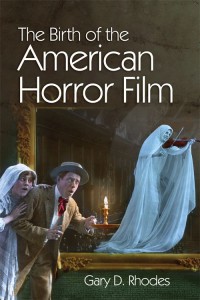The Birth of the American Horror Film


Average rating: ![]()
| 0 | rating | |
| 0 | rating | |
| 0 | rating | |
| 0 | rating |
Your rating: -
Book Presentation:
Explains how the American horror movie came into existence
Although early cinema has long been a key area of research in film studies, the origin and development of the horror film has been a neglected subject for what is arguably one of the world’s most popular film genres. Using thousands of primary sources and long-unseen illustrations, The Birth of the American Horror Film examines a history that begins in colonial Salem, taking an interdisciplinary approach to explore the influence of horror-themed literature, theatre and visual culture in America, and how that context established an amorphous structural foundation for films produced between 1895 and 1915. Exhaustively researched, bridging scholarship on Horror Studies and Early Cinema, The Birth of the American Horror Film is the first major study dedicated to this vital but often overlooked subject.
Read an interview with Gary Rhodes on SYFYWIRE
Key features
• The first scholarly book dedicated to the birth of the American horror film
• Bridges scholarship on Horror Studies and Early Cinema
• Examines pre-cinema (literature, theatre and visual culture), as well as major works in early horror-themed cinema
• Suitable for use on courses focusing on Film History, Genre and Horror
About the Author:
Gary D. Rhodes is Professor of Media, Oklahoma Baptist University. He is the author of Emerald Illusions: The Irish in Early American Cinema (2012), The Perils of Moviegoing in America (2012), and The Birth of the American Horror Film (2018). He is a founding editor of Horror Studies: An Interdisciplinary Journal. Rhodes is also the writer-director of the documentary films Lugosi: Hollywood's Dracula (1997) and Banned in Oklahoma (2004).
Press Reviews:
In a remarkable work of historical research, Gary Rhodes provides what must certainly be the definitive study of the origins of the horror film genre. First, he traces the manifestations of "horror-themed" material well back into the 18th century, considering literature, theater, graphic arts, freak shows, lurid news stories—anything likely to raise a thrill of horror. He then turns to early cinema—the peep shows, the nickelodeons—covering its development from 1895 to 1915. Most popular of the horror figures were witches, ghosts, and devils, but almost all future familiar frights were represented—vampires, werewolves, mummies, monsters, mad scientists, mesmerists, somnambulists, aliens, sinister "others." The only horror missing from the period was the zombie. Rhodes also enumerates the films based on the works of Washington Irving, Nathaniel Hawthorne, and—especially—Edgar Allan Poe. The sheer volume of films produced is astonishing. Most are lost, of course, but Rhodes does a magnificent job of resurrecting them, using advertising copy, publicity stills, trade magazines, and film criticism to recuperate plots and some notion of style.– W. A. Vincent, Michigan State University, CHOICE
The Birth of the American Horror Film is a handsome book filled with reproductions of film stills, photographs and illustrations. Rhodes’ work triggers a cumulative effect of wide-ranging association. One is left with a comprehensive overview of numerous related topics in the service of a measured thesis. I read with interest and pleasure, as Rhodes’s prose if remarkably lucid, his considerations important.– Anne Golden, Monstrum
This is a meticulous study of the intermedial roots and manifestations of horror-themed cinema in all its varieties prior to 1915. The depth and scope of Rhodes’ erudite scholarship make this an indispensable read for everyone interested in one of the most persistent features of American cinema of all ages: horror.– Professor Jan Olsson, Stockholm University
A fascinating and overdue study. This book demonstrates the multiple different contexts out of which the horror film was born. Essential reading for anyone interested in the history of horror film– Professor Mark Jancovich, University of East Anglia
See the publisher website: Edinburgh University Press
> From the same author:
The Films of Budd Boetticher (2017)
Dir. Gary D. Rhodes and Robert Singer
Subject: Director > Budd Boetticher
No Traveler Returns (2012)
The Lost Years of Bela Lugosi
by Gary D. Rhodes and Bill Kaffenberger
Subject: Actor > Bela Lugosi
Stanley Kubrick (2007)
Essays on His Films and Legacy
Dir. Gary D. Rhodes
Subject: Director > Stanley Kubrick
Docufictions (2005)
Essays on the Intersection of Documentary and Fictional Filmmaking
Dir. Gary D. Rhodes and John Parris Springer
Subject: Genre > Documentary
> On a related topic:
The Routledge Companion to American Film History (2025)
Dir. Pamela Robertson Wojcik and Paula J. Massood
Subject: History of Cinema
The Sixties, 1960-1969 (2003)
History of American Cinema vol.8
by Paul Monaco
Subject: History of Cinema
The Fifties, Transforming the Screen 1950–1959 (2003)
History of Amarican cinema vol.7
by Peter Lev
Subject: History of Cinema
American Cinema and Hollywood (2000)
Critical Approaches
Dir. John Hill and Pamela Church Gibson
Subject: History of Cinema
Boom & Bust, American Cinema in the 1940s (1999)
History of American Cinema vol.6
Subject: History of Cinema
Girls Will Be Boys (2016)
Cross-Dressed Women, Lesbians, and American Cinema, 1908-1934
by Laura Horak
Subject: Sociology
The Transformation of Cinema 1907-1915 (1994)
History of the American Cinema vol.2
Subject: Silent Cinema